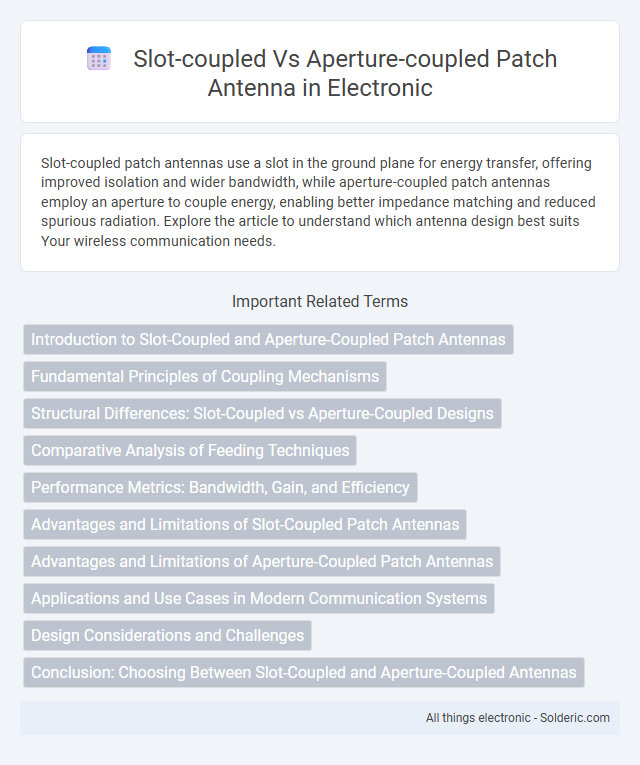Slot-coupled patch antennas use a slot in the ground plane for energy transfer, offering improved isolation and wider bandwidth, while aperture-coupled patch antennas employ an aperture to couple energy, enabling better impedance matching and reduced spurious radiation. Explore the article to understand which antenna design best suits Your wireless communication needs.
Comparison Table
| Feature | Slot-Coupled Patch Antenna | Aperture-Coupled Patch Antenna |
|---|---|---|
| Coupling Mechanism | Slot etched in the ground plane couples energy to patch | Energy couples through an aperture between feed line and patch |
| Isolation | Moderate isolation between feed and radiating patch | High isolation due to separate feed and patch layers |
| Bandwidth | Narrow bandwidth, typically a few percent | Wider bandwidth, 5-10% typical |
| Fabrication Complexity | Relatively simple; single substrate and ground plane | More complex; multi-layer substrates required |
| Polarization Control | Limited polarization control | Better polarization flexibility due to aperture design |
| Applications | Compact antennas where simplicity is key | Wideband applications requiring high isolation |
| Typical Frequency Range | GHz range, often 1-10 GHz | GHz range, suitable for 2-18 GHz spans |
Introduction to Slot-Coupled and Aperture-Coupled Patch Antennas
Slot-coupled and aperture-coupled patch antennas are advanced microstrip antenna designs used for improved impedance matching and isolation between the feed network and the radiating element. Slot-coupled antennas utilize a narrow slot in the ground plane to electromagnetically couple energy from the feed line to the patch, enhancing bandwidth and minimizing spurious radiation. Aperture-coupled antennas employ a larger aperture or slot to couple the electromagnetic energy, offering greater flexibility in feed positioning and better isolation for high-performance wireless communication systems.
Fundamental Principles of Coupling Mechanisms
Slot-coupled patch antennas utilize an electromagnetic coupling through a narrow slot etched on the ground plane, enabling energy transfer between the feed line and the radiating patch without direct electrical contact. Aperture-coupled patch antennas employ a similar slot mechanism but typically incorporate an additional dielectric substrate, allowing for enhanced isolation between the feed network and the radiating element. Both coupling techniques rely on the magnetic field interaction across the aperture, but aperture coupling provides superior bandwidth and polarization agility due to its layered structure.
Structural Differences: Slot-Coupled vs Aperture-Coupled Designs
Slot-coupled patch antennas feature a slot etched directly on the ground plane beneath the patch, serving as the electromagnetic coupling mechanism between the feed line and the radiating element. Aperture-coupled patch antennas utilize an aperture or slot in the ground plane, but the feed line is located on a separate substrate layer, providing improved isolation and tunability. Structural differences influence bandwidth, radiation efficiency, and ease of fabrication, with aperture-coupled designs offering enhanced performance in multilayer configurations compared to slot-coupled counterparts.
Comparative Analysis of Feeding Techniques
Slot-coupled patch antennas utilize a slot in the ground plane to couple energy from the feed line to the patch, providing improved isolation between the feed network and the radiating element for enhanced bandwidth and reduced cross-polarization. Aperture-coupled patch antennas employ a similar slot but optimize the feed positioning and substrate thickness to achieve better impedance matching and higher gain, especially useful in multilayer configurations. Compared to slot-coupled designs, aperture-coupling offers greater design flexibility and improved performance for complex, multilayer antenna systems used in advanced wireless communication applications.
Performance Metrics: Bandwidth, Gain, and Efficiency
Slot-coupled patch antennas typically offer moderate bandwidth and gain with good isolation between the feed and radiating elements, while aperture-coupled patch antennas excel in wider bandwidth and higher gain due to better electromagnetic coupling. Efficiency in aperture-coupled designs tends to be higher as the feed conductor is separated from the radiating patch by a dielectric layer, reducing loss and surface wave excitation. Your choice depends on prioritizing either enhanced bandwidth and gain with aperture coupling or simpler fabrication with slot-coupling for specific application needs.
Advantages and Limitations of Slot-Coupled Patch Antennas
Slot-coupled patch antennas offer improved isolation between the feed network and radiating element, reducing spurious radiation and enhancing bandwidth compared to aperture-coupled designs. You benefit from easier fabrication and better control over the antenna's impedance matching through a simpler feed structure. However, these antennas may suffer from weaker coupling efficiency and limited gain, restricting their use in high-performance applications.
Advantages and Limitations of Aperture-Coupled Patch Antennas
Aperture-coupled patch antennas offer enhanced isolation between the feed network and radiating element, resulting in reduced spurious radiation and improved bandwidth compared to slot-coupled designs. Their multilayer structure allows flexible impedance matching and integration with complex feeding mechanisms, benefiting high-frequency wireless communication applications. You should consider fabrication complexity and increased design sensitivity, which may lead to higher manufacturing costs and stringent alignment requirements.
Applications and Use Cases in Modern Communication Systems
Slot-coupled patch antennas excel in compact, low-profile applications such as satellite communication and mobile devices due to their ease of integration and broad bandwidth capabilities. Aperture-coupled patch antennas offer superior isolation and polarization purity, making them ideal for advanced radar systems, smart antennas, and MIMO (Multiple Input Multiple Output) technologies in 5G networks. Both antenna types are integral to modern communication systems where space constraints, performance, and frequency diversity are critical.
Design Considerations and Challenges
Slot-coupled patch antennas require precise alignment between the slot and patch to minimize impedance mismatches, while aperture-coupled designs rely on a separate coupling aperture, offering improved isolation and reduced spurious radiation. You must consider substrate thickness and dielectric constant carefully for both types, as these parameters significantly impact bandwidth and efficiency. Challenges include managing cross-polarization effects in slot-coupled antennas and ensuring mechanical stability in the multilayer structure of aperture-coupled designs.
Conclusion: Choosing Between Slot-Coupled and Aperture-Coupled Antennas
Slot-coupled patch antennas offer enhanced isolation and easier integration with planar circuits, making them ideal for compact, high-frequency applications. Aperture-coupled antennas provide superior bandwidth and improved polarization diversity, suited for wideband and multi-band wireless systems. The choice depends on application requirements: prioritize slot-coupled for integration and compactness, and aperture-coupled for bandwidth and polarization performance.
slot-coupled vs aperture-coupled patch antenna Infographic

 solderic.com
solderic.com